8 Strategies For Customer Delight Experience in 2025
Customer delight goes beyond satisfaction, aiming to exceed expectations and create memorable experiences. It promotes loyalty and positive word-of-mouth, driving long-term success.

Customer delight goes beyond satisfaction, aiming to exceed expectations and create memorable experiences. It promotes loyalty and positive word-of-mouth, driving long-term success.

Ever wonder how can businesses stand out and truly delight their customers? Customer delight goes beyond meeting expectations and aims to create memorable experiences that keep customers coming back for more.
Satisfied customers are not enough to ensure loyalty and repeat business. Businesses must go above and beyond to exceed customer expectations. It is the key to retaining the customers. After all, a mere 5% improvement in customer retention results in profit growth of more than 25%
Customer delight strategy is more than just providing good customer service, it involves anticipating and fulfilling customers’ needs in a way that exceeds their expectations. Businesses that prioritize customers will see increased customer loyalty, positive word-of-mouth referrals and greater success in the marketplace. Here we will discuss the importance of delightful customers and provide tips for how businesses can achieve it.
Customer delight refers to the process of exceeding customer expectations to create a positive emotional reaction, leading to long-term loyalty and advocacy. It goes beyond basic satisfaction by delivering unexpected value, personalized experiences or exceptional service that makes customers feel genuinely valued. The emotional high point transforms satisfied customers into loyal advocates who return again and again.
The process begins with a deep understanding of what truly matters to your customers. When you carefully listen to their feedback and observe behavior patterns, it is possible to identify opportunities to create surprising positive experiences that resonate on a personal level. These thoughtful gestures show customers you value them as individuals, not just transactions.
Key objectives:
Let us go through the essential principles that will transform your approach and help facilitate deeper connections with your customers, ensuring they keep returning for more.
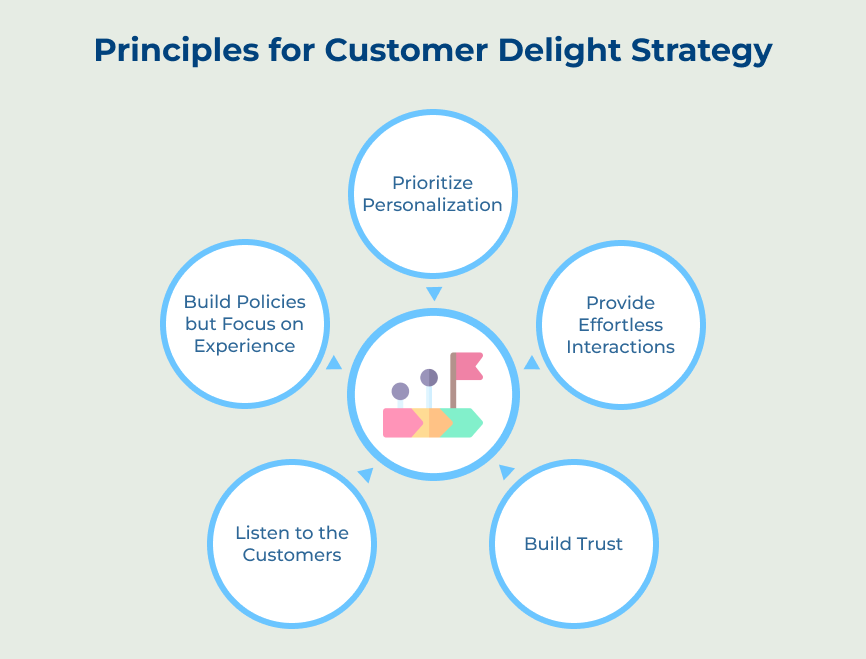
One of the most important aspects of customer delight is listening to what the customers have to say. Over 50% of customers will switch to a competitor after a single unsatisfactory customer experience. Whether it’s through surveys, feedback forms or social media interactions, taking the time to listen to the customer’s concerns is important. It helps businesses tailor the products or services to better meet their expectations.
Having policies or procedures in place is important for consistency and efficiency, it’s equally important to focus on the customer experience. Customers should feel valued, respected and appreciated at every touchpoint with the business. Prioritizing the customer experience allows businesses to create a positive and memorable interaction that keeps customers coming back.
Customers expect personalized experiences that cater to their unique preferences and needs. A significant 74% of customers express frustration when website content lacks personalization. Collecting data on customer preferences allows businesses to tailor their products, services and marketing efforts to create a more personalized experience for each customer. It can lead to increased customer satisfaction and loyalty.
Customers value convenience and efficiency. Making it easy for customers to interact with the business, whether it’s through a user-friendly website, quick response times to inquiries or seamless transactions, can help create a positive experience that delights customers. Removing barriers to effective communication and streamlining processes allows businesses to ensure that customers have a hassle-free experience.
Trust is essential for building long-term relationships with customers. Being transparent, reliable and honest in their interactions with customers allows businesses to build trust. Delivering on promises, resolving issues effectively and consistently providing high-quality solutions can help build a strong foundation of trust with the customers.
Going the extra mile to create a memorable experience for the customers allows businesses to build brand loyalty and increase customer satisfaction. Here are five benefits of customer delight:
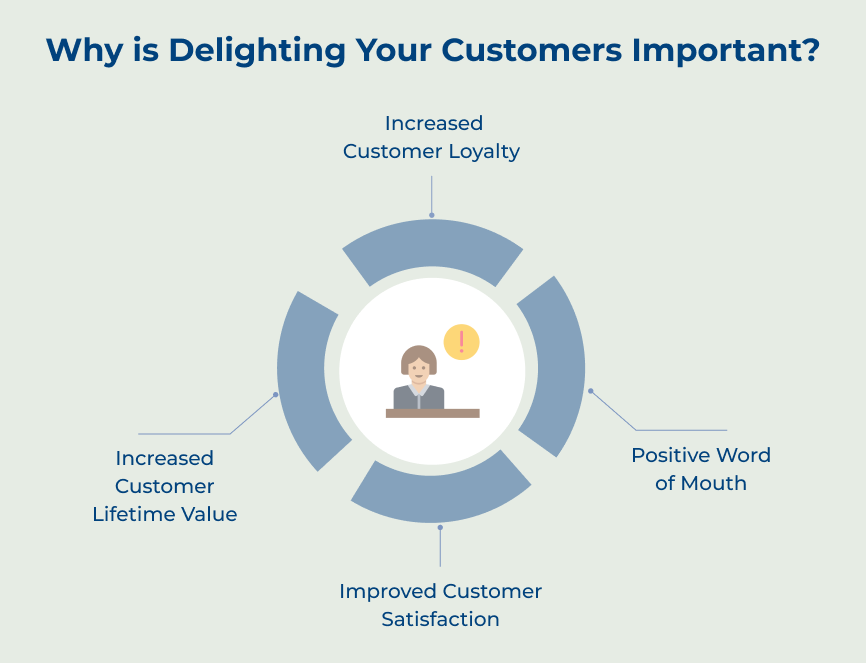
1. Increased customer loyalty: When businesses consistently exceed the customer’s expectations and provide them with exceptional service, they are more likely to become repeat customers. Going the extra mile to make the customers happy allows businesses to build trust and loyalty, leading to long-term relationships that are beneficial for both parties.
2. Positive word of mouth: Delightful customers are more likely to recommend the business to their friends and family. Word-of-mouth marketing is incredibly powerful, as people are more likely to trust recommendations from people they know. 92% of consumers trust recommendations over a company’s messaging.
3. Improved customer satisfaction: Delightful customers are happy customers. Providing exceptional service and exceeding their expectations allows businesses to ensure that their customers are satisfied with their interactions with the business. Satisfied customers are more likely to leave positive reviews, refer others to the business and continue doing business in the future.
4. Increased customer lifetime value: When businesses delight customers, it can increase the lifetime value of the business. Happy customers are more likely to make repeat purchases, purchase additional products or services and spend more money with the business over time. Focusing on delighting the customers allows organizations to maximize their value and increase their overall revenue.
Following are some straightforward yet powerful strategies to elevate your customer interactions and turn satisfaction into delight. Get ready to transform the way you connect with your customers!
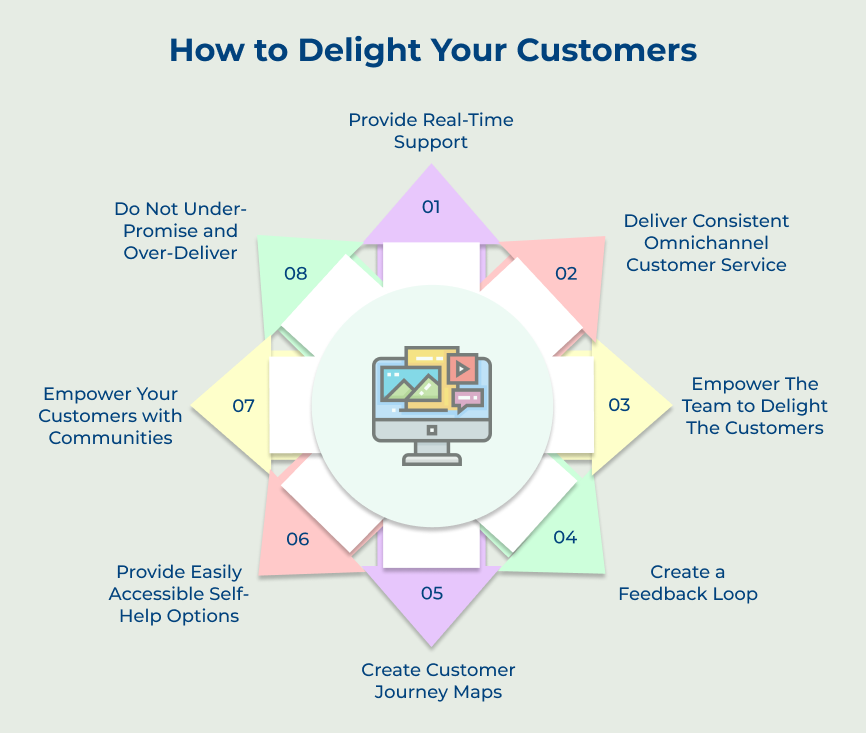
Providing real-time support is a crucial strategy for businesses looking to delight their customers. Offering immediate customer queries allows businesses to showcase their dedication to customer satisfaction and build trust with their clientele. 53% of customers expect real-time assistance, emphasizing the need for businesses to provide instant and proactive support.
Implementing a live chat feature on a website allows customers to connect with a representative instantly, leading to quicker resolutions and a more positive customer experience. Real-time support can also help businesses to stand out from competitors who may not offer such timely assistance.
Best practices:
Delivering consistent omnichannel customer service is crucial for businesses looking to delight their customers. The strategy involves providing a seamless and integrated experience across all channels. It ensures that customers receive the same level of service and information regardless of how they interact with the brand allowing businesses to build trust with the audience.
One example of the strategy in action is a retail company that offers customers the option to shop online, in-store or through a mobile app. Customers can easily check product availability, make purchases and contact customer service through any channel. It can be done depending on their preferences or purchase history seamlessly transferred between platforms.
Best practices:
Empowering the team to delight the customers is a proven strategy that can lead to increased customer satisfaction, loyalty and ultimately, business success. Start by investing in training and development for the team. Provide them with the knowledge and skills they need to deliver exceptional customer service. Encourage them to take ownership of customer interactions and empower them to make decisions that will benefit the customer.
One example of this in action is Zappos. They are an online shoe retailer known for its exceptional customer service. Zappos empowers its employees to do whatever it takes to make customers happy, whether that means sending a replacement pair of shoes overnight or refunding a purchase, no questions asked.
Best practices:
Creating a feedback loop is a crucial strategy for businesses looking to continuously improve and delight their customers. The strategy involves gathering feedback from customers, analyzing that feedback and implementing changes based on the insights gained. Actively acting on customer feedback allows businesses to enhance their solutions, improve customer satisfaction and increase loyalty.
Let’s take an example, a company may send out customer surveys after purchases or interactions to gather feedback on their experience. They can then use this feedback to identify areas for improvement, such as product quality, customer service or website usability.
Best practices:
Customer journey maps are a powerful tool that businesses can use to understand their customers’ experiences and interactions with their brands. The strategy helps to delight customers by allowing businesses to anticipate their needs and personalize interactions. Understanding the customer journey allows companies to tailor their marketing messages and offers to meet the customer at the right time.
Let’s explore an example, a customer journey map might reveal that customers are getting frustrated with the checkout process on an e-commerce website. Identifying this pain point allows the business to make changes to streamline the process and make it easier for customers to make a purchase.
Best practices:
Providing easily accessible self-help options is a key strategy in delighting customers and improving their overall experience with the brand. Offering resources and tools for customers to solve their problems on their own allows businesses to significantly improve customer satisfaction and loyalty. Over 60% of customers are expected to prefer self-service options.
Creating a comprehensive FAQ page on a website, including chatbots for instant assistance or offering self-service options can be vital. It can help businesses empower customers to find solutions independently.
Best practices:
Empower the customers with communities by creating a space where they can connect, share and engage with each other. Empowering the customers with communities, organizations are giving them a platform to voice their opinions, ask questions and share their experiences with other like-minded individuals. The sense of community can lead to higher customer satisfaction, as customers feel valued and heard.
An example of this strategy in action is the online community created by beauty brand Glossier. Glossier’s community platform allows customers to engage with each other, share beauty tips or product recommendations and provide feedback directly to the brand. It has helped Glossier build a loyal customer base and drive new product launches based on customer feedback.
Best practices:
Do not under-promise or over-deliver is a key strategy in customer service that involves setting realistic expectations for the customers and then surpassing those expectations with exceptional service or product delivery. The strategy helps to delight customers by creating a positive experience and exceeding their expectations, leading to increased customer satisfaction.
Let’s explore an example, if a company promises to deliver a product within 5 business days and then delivers it within 3 days, the customer will be pleasantly surprised. The customer will be impressed with the faster-than-expected service.
Best practices:
Following are the crucial metrics you should be tracking to gauge customer delight effectively and create a loyal customer base that advocates for your business.
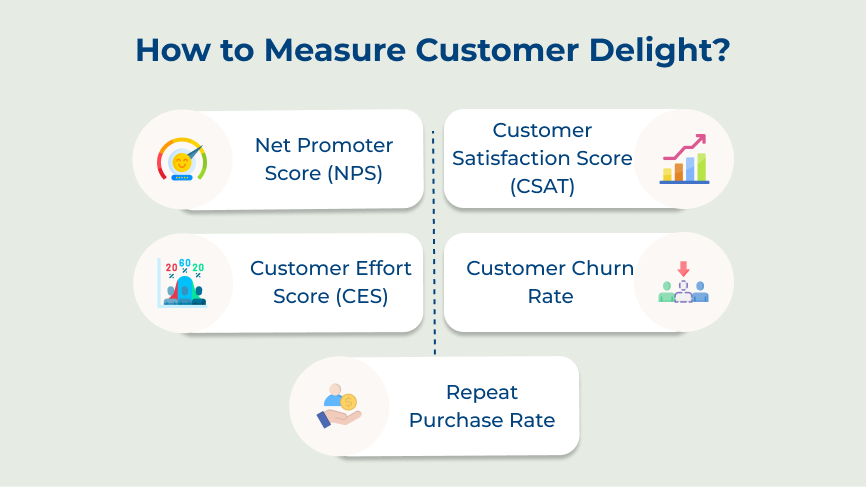
NPS is a widely used metric that measures customer loyalty by asking them a simple question: “On a scale of 0-10, how likely are you to recommend our company to a friend or colleague?” Customers who answer with a 9 or 10 are considered promoters, those who answer with a 7 or 8 are passive and those who answer with a 6 or below are detractors. Calculating the NPS score allows businesses to gauge how delighted their customers are with the brand.
CSAT is a metric that measures how satisfied customers are with a specific interaction or experience they had with the brand. It is usually measured by asking customers to rate their satisfaction on a scale of 1-5 or 1-10 after a customer support call, purchase or any other touchpoint. Monitoring the CSAT score allows businesses to assess how delighted customers are with individual interactions or experiences.
CES measures how easy or difficult it is for customers to do business with the company. It is usually measured by asking customers to rate how much effort they had to put into resolving an issue, making a purchase or completing a task. The easier it is for customers to interact with the brand, the more delighted they are likely to be.
Repeat purchase rate is a metric that measures how often customers come back to purchase the brand. A high repeat purchase rate indicates that customers are delighted with their previous experiences and are likely to continue doing business with the organization in the future. Monitoring this metric allows businesses to gauge customer loyalty and satisfaction.
Customer churn rate measures the percentage of customers who stop doing business with your company within a specific time. A high churn rate indicates that customers are not delighted with their experiences and are leaving the brand. Analyzing the churn rate enables organizations to identify areas for improvement and take proactive steps to increase customer delight.
Check out the key differences between these two concepts and provide insights on how to facilitate customer delight, ensuring your brand not only meets expectations but exceeds them consistently.
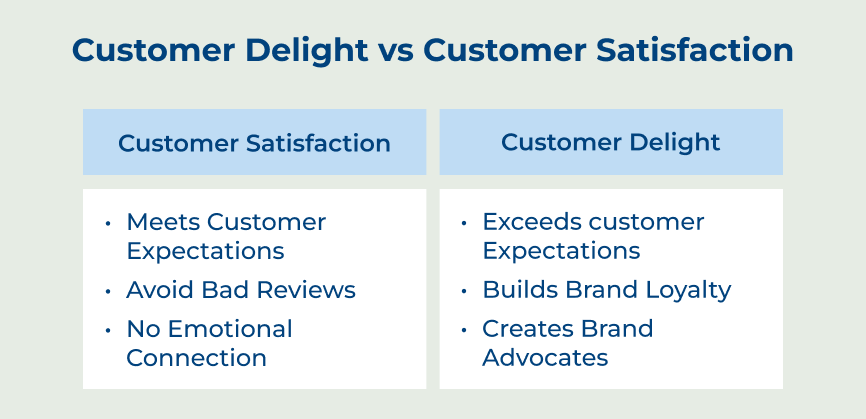
Customer satisfaction is typically based on rational factors such as product quality, price and customer service. It is an overall evaluation of whether a customer’s expectations were met.
Customer delight goes beyond meeting expectations to exceeding them in a way that creates an emotional response. It involves surprising and delighting customers with exceptional service or products that go beyond what they expect.
Customer satisfaction is important for retaining customers and encouraging repeat business. Satisfied customers are likely to return to a business for future purchases.
Customer delight goes a step further by creating loyal customers who are not only likely to return but also to recommend the business to others. Delighted customers are more likely to become brand advocates and help promote the business through word-of-mouth referrals.
Customer satisfaction is often focused on meeting customer expectations. Businesses aim to deliver products or services that meet the basic requirements of customers and fulfill their needs.
Customer delight is about exceeding customer expectations and surprising them with experiences that they may not have even realized they wanted. It involves understanding customer needs on a deeper level and finding ways to go beyond to create memorable experiences.
Customer satisfaction is often viewed as a transactional concept, where customers evaluate their satisfaction based on each interaction with a business. It is focused on meeting immediate needs and resolving any issues that may arise.
Customer delight is more of a relational concept that focuses on building long-term relationships with customers. It involves creating emotional connections and personalized experiences that make customers feel valued.
Customer satisfaction is important for ensuring that customers are happy with their current experience with a business. It can lead to short-term loyalty and repeat business.
Customer delight has a long-term impact on customer relationships and brand loyalty. Consistently delighting customers with exceptional experiences allows businesses to build strong relationships that lead to continued loyalty and advocacy.
Check out some inspiring examples of customer delight that demonstrate the power of exceeding expectations and highlight actionable insights to incorporate into your customer service approach.
1. Zappos
Zappos is renowned for its exceptional customer service. The company’s core value is to “deliver wow through service” and they have built their entire business model around creating a delightful experience for customers. Zappos offers free shipping on all orders, a 365-day return policy and 24/7 customer support. They have also implemented surprise upgrades to expedited shipping for some customers, going above and beyond to exceed expectations.
2. Amazon
Amazon is another brand that is known for its customer-centric approach. The company has a dedicated team focused on customer satisfaction, constantly seeking ways to improve the shopping experience for customers. Amazon’s personalized recommendations, easy return process and fast delivery options are just a few examples of how they prioritize delightful customers.
3. Nordstrom
Nordstrom is a luxury department store that prides itself on providing exceptional customer service. The company empowers its employees to go above and beyond for customers. They offer tailor-made recommendations, providing alterations on the spot, or even hand-delivering purchases to a customer’s home. Nordstrom’s commitment to customer delight has earned them a loyal customer base.
4. Warby Parker
Warby Parker is an eyewear retailer that has disrupted the traditional eyeglass industry by offering affordable, stylish glasses with exceptional customer service. The company allows customers to try on glasses at home for free, offers virtual try-on options and provides a seamless online shopping experience. Warby Parker’s commitment to delightful customers has set them apart from competitors in the industry.
Below are the most common mistakes in customer delight along with the solutions to overcome them, ensuring you have the tools to facilitate loyalty and turn every interaction into a positive one.
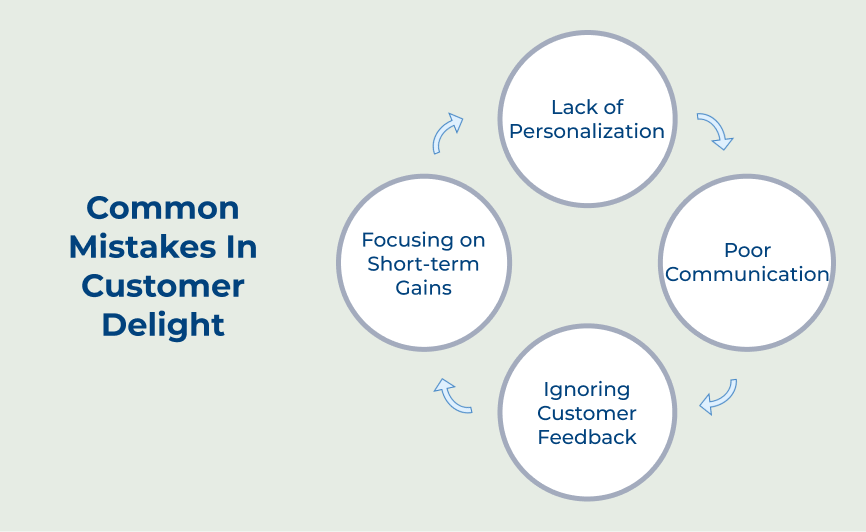
One of the biggest mistakes companies make is failing to personalize their interactions with customers. Customers expect businesses to know their preferences and provide personalized recommendations. Businesses should invest in customer relationship management (CRM) software to track customer interactions and tailor their communications to offers accordingly.
Another common mistake in customer delight is poor communication. Whether it’s long response times to customer inquiries or lack of updates on order status, poor communication can lead to frustration and disappointment among customers.
Companies should ensure clear communication with customers through various channels such as email, phone and social media. Setting up automated response systems and regularly updating customers on the status of their orders can help improve communication. It also enhances the overall customer experience.
Many companies make the mistake of ignoring customer feedback, whether it’s positive or negative. Customer feedback is a valuable source of information that can help businesses identify areas for improvement and make necessary changes to enhance the customer experience.
Make sure to actively seek customer feedback through surveys, reviews and social media channels. Analyzing customer feedback and implementing necessary changes based on their suggestions can help businesses build stronger relationships with their customers to improve customer satisfaction levels.
Some companies make the mistake of prioritizing short-term gains over long-term customer relationships. It’s important to drive sales, focusing solely on short-term gains can lead to neglecting customer relationships and failing to deliver exceptional customer experiences.
Adopt a customer-centric approach and prioritize building long-lasting relationships with the customers. Providing exceptional customer service, offering personalized recommendations and rewarding loyal customers can help businesses promote customer loyalty.
Implementing customer delight strategy can truly elevate the overall customer experience. Going beyond to exceed customer expectations allows businesses to create loyal customers who are more likely to return and spread positive word of mouth.
Providing exceptional customer service, personalized interactions and memorable experiences all contribute to delightful customers. Businesses need to prioritize their customers to build strong, lasting relationships with their customers. Happy customers lead to successful businesses.
Everyone in the company is responsible for delighting prospects and customers. The sales team first interacts with prospects to the customer service team who ensures satisfaction post-purchase, every employee plays a crucial role in creating a positive experience. It is a team effort to ensure that customers are not only satisfied but delighted with their interactions with the company.
Providing delight to customers means exceeding their expectations, creating memorable experiences that leave them feeling happy, satisfied and appreciated. It involves going beyond in the products or services, offering exceptional customer service and personalizing interactions to make them feel valued. Delighting customers builds loyalty and encourages repeat business.
Customer delight matters because it creates loyal customers who are more likely to repeat purchases and recommend the business to others. Exceeding customer expectations and providing exceptional service allows businesses to build a positive reputation. Happy customers are also more likely to leave positive reviews and feedback, helping to attract new customers.
Businesses can achieve customer delight by exceeding expectations and providing exceptional customer service. It can be done through personalized interactions, anticipating customer needs, resolving issues promptly and constantly seeking feedback for improvement. Focusing on creating memorable experiences and building strong relationships with customers allows businesses to ultimately create satisfied customers.
Creating a culture of customer delight starts with the employees. Train the team to prioritize customer satisfaction, empower them to make decisions that benefit customers and reward them for delivering exceptional service. Encourage a customer-centric mindset throughout the organization to ensure that every interaction with customers is positive and memorable.

Market better, sell faster and support smarter with Veemo’s Conversation Customer Engagement suite of products.
Unify all your customer data in one platform to deliver contextual responses. Get a 360 degree view of the customer lifecycle without switching tools.
Connect with the tools you love to reduce manual activities and sync your business workflows for a seamless experience.
 https://veemo.io/wp-content/uploads/2024/12/customer-service-response-time.png
1256
2400
Webvision Solution
https://veemo.io/wp-content/uploads/2024/11/veemo.svg
Webvision Solution2025-10-17 10:51:142025-10-17 10:51:149 Effective Tips to Reduce Customer Service Response Time
https://veemo.io/wp-content/uploads/2024/12/customer-service-response-time.png
1256
2400
Webvision Solution
https://veemo.io/wp-content/uploads/2024/11/veemo.svg
Webvision Solution2025-10-17 10:51:142025-10-17 10:51:149 Effective Tips to Reduce Customer Service Response Time https://veemo.io/wp-content/uploads/2024/10/How-to-Create-Knowledge-Base.png
1257
2400
Vikas Sachan
https://veemo.io/wp-content/uploads/2024/11/veemo.svg
Vikas Sachan2024-10-21 12:24:342025-11-03 07:13:21How to Create a Knowledge Base in 9 Easy Steps: The Ultimate Guide
https://veemo.io/wp-content/uploads/2024/10/How-to-Create-Knowledge-Base.png
1257
2400
Vikas Sachan
https://veemo.io/wp-content/uploads/2024/11/veemo.svg
Vikas Sachan2024-10-21 12:24:342025-11-03 07:13:21How to Create a Knowledge Base in 9 Easy Steps: The Ultimate Guide https://veemo.io/wp-content/uploads/2024/02/Live-Chat-for-Sales.png
628
1200
teamwebvisionsolution@gmail.com
https://veemo.io/wp-content/uploads/2024/11/veemo.svg
teamwebvisionsolution@gmail.com2024-10-21 11:31:222025-08-06 10:22:06How to Use Live Chat for Sales? 7 Proven Ways to Grow Revenue
https://veemo.io/wp-content/uploads/2024/02/Live-Chat-for-Sales.png
628
1200
teamwebvisionsolution@gmail.com
https://veemo.io/wp-content/uploads/2024/11/veemo.svg
teamwebvisionsolution@gmail.com2024-10-21 11:31:222025-08-06 10:22:06How to Use Live Chat for Sales? 7 Proven Ways to Grow RevenueGrow Customer Relationships and stronger team collaboration with our range of products across the Conversational Engagement Suite.

 How to Scale Customer Support: A Guide with Strategies and Steps
Scroll to top
How to Scale Customer Support: A Guide with Strategies and Steps
Scroll to top